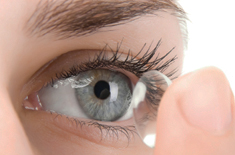| Contact Lenses |
 |
|
|
| |
 |
What is a Contact Lens? |
| |
A contact lens is a thin, curved lens placed on the film of tears that covers the surface of the eye. The lens itself is naturally clear, but is often given the slightest tinge of color to make them easier for wearers to handle. Today’s contact lenses are either hard or soft. Most people wear the latter form now, but it wasn’t too long ago that contact lenses were even glass blown.
|
 |
History of Contact Lenses |
| |
While contact lenses may seem to be a modern addition to eye care, they actually have a, lond and illustrious history kick-started by none other than Leonardo da Vinci and Rene Descartes. It wasn’t until the late 19th century, however, that a German glassblower produced a lens that could be seen through and reasonably tolerated, and a German ophthalmologist came up with and fitted the first contact lens, which could be worn for a few hours at a time.
There are 3 main types of lens;
1- Hard : made of PMMA (polymethylmethacrylate) or Perspex.
2- Rigid Gas Permeable (RGP): made of mixture of a hard and a soft material.
3- Soft (hydrophilic): made of HEMA (hydroxyl-ethyl-methacrylate). |
 |
Hard Lenses: Advantages & Disadvantages |
| |
These lenses cover the part of the part of the cornea and have a diameter of 7-10.5mm.
Advantages
1. Most durable and cheap.
2. Cleaning and maintenance are easy.
3. Can correct the astigmatism in a greater extent.
4. Less chance of Corneal infection.
Disadvantages
1- Only suitable for daily wear for short duration.
2- Not permeable to atmospheric oxygen, so cornea suffers from quick hypoxia leading to epithelial oedema.
3- Most uncomfortable, and require adaptation by progressive increase in wearing time.
4- May give rise to annoying glare at night. |
 |
Rigid Gas Permeable (RGP) lenses: Advantages & Disadvantages |
| |
They also cover the part of the cornea.
Advantages
1- Permeable to atmospheric oxygen in variable amount.So, the cornea does not suffer from hypoxia.
2- Suitable for daily wear, but for a longer duration than hard lens.
3- Others are same as hard lens.
Disadvantages
1- Less durable and costly.
2- Less comfortable (though little better than hard lens)and require slow adaptation.
3- Tend to scratch more easily. |
 |
Soft Lenses: Advantages & Disadvantages |
| |
They cover the entire cornea and extend 1-2mm over the sclera.They have a diameter of 13-14.5 mm.The amount of oxygen passing through the lens is directly related to its water content.
They are used as daily wear ,extended wear(more than 24 hours) and as therapeutic bandage lenses.
Advantages
1- Can be used both in day and at night.
2- Most comfortable and do not require adaptation time.
3- Lens loss is less.
Disadvantages
1- More delicate ,more easily damaged and have a shorter life.
2- Can not correct astigmatism more then 0.5 -1.0 diopter.Toric lenses are required for correction of astigmatism more than 1.00 diopter.
3- Cleaning and maintenance of the lenses are difficult.
4- Associated with higher incidence of corneal infection. |
 |
Indications of Contact Lenses |
| |
A Optical
About 95%of the contact lenses are worn as an alternative to glasses.
1- Myopia is the most common indication.
2- Aphakia particularly in unilateral aphakia , and aphakia following congenital cataract operation.
3- Astigmatism ,irregular astigmatism,as in fine nebular opacity ,keratoconus etc.
4- Anisometropia.
5- High hypermetyropia.
B Therapeutic
By soft bandage contact lenses and the indications are;
1- Bullous Keratopathy
2- Recurrent corneal Erosion Syndrome
3- Filamentary Keratopathy
4- Persistent epithelial healing defects.
5- Dry eye syndrome and chemical burns – to prevent symblepharon formation.
6- Wound leaks ,along with tissue adhesives.
C Diagnostic
1-Fundus contact lens
2-Goldmanns three mirror contact lens.
3-Radio opaque contact lens for diagnosis of intra ocular foreign body.
4-Goniolens
5-Lenses for laser therapy.They are mainly used along with slit lamp which allows a binocular,magnified view.
D Miscellaneous
1-Cosmetic to hide an unsighty corneal scar with no PL
2-Vehicle for drug delivery e.g.contact lens soaked in pilocarpine.
3-Protective as in aniridia or albinism with painted iris and a central clear pupillary area.
4-Occluders for treatment of amblyopia in children who can not tolerate conventional occlusion.
5-Occupational practically useful among sportmen, sales girl ,actors etc. |
 |
Complications of Contact Lenses |
| |
They are more common with soft lenses ,especially with the extended wear type
1- Conjunctival Complications
(A) Allergic Conjunctivitis mainly related to allergy to the preservatives (e.g. thiomersal) present in contact lens cleaning solution.
(B) Giant Papillary Conjunctivitis (GPC) It has an immunologic origin in which contact lens deposits, especially proteins act as allergens.
2- Corneal Complications
(A) Epithelial Oedema mainly due to hypoxia (Sattler,s veil)
(B) Peripheral Corneal Vascularisation
(C) Sterile Corneal Ulceration which usually heals ,once wear has been discontinued.
(D) Infection, particularly pseudomonas keratitis and acanthamoeba keratitis are most serious.
(E) Warpage of the cornea resulting in severe and permanent astigmatism.
3- Problems with the contact lense
(A) Lens Deposits e.g. muco proteins, calcium, lipid or even micro –organisms can adhere to the lens surface.
(B) Lens Digestion , microorganisms, particularly fungi can digest lens material while growing into it.
(C) Lens spoilage , due to aging ,loss of lens shape, discolouration and by manual trauma.
|
|
| |
Author: Dr. Sanjay Dhawan
Last Updated on: 1 March, 2014 |
| |
|
|
|
